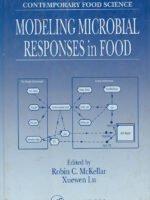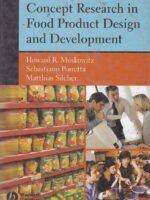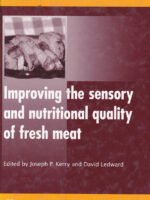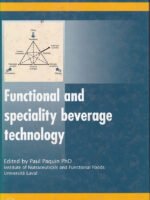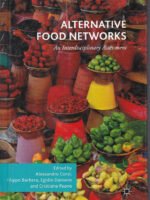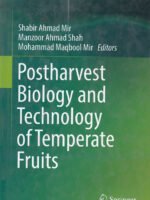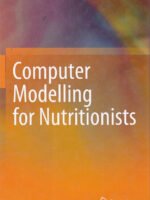-
Modeling Microbial Responses in Food
₹9,519.00The book includes strategies for combining databases, improving researcher networks, and standardization of applications packages. Providing the uninitiated with enough information to begin developing their own models, Modeling Microbial Responses in Foods covers all aspects of growth and survival modeling from the primary stage of gathering data to the implementation of final models in appropriate delivery systems.
₹21,699.00 -
Sensory-Directed Flavor Analysis
₹10,500.00Sensory-Directed Flavor Analysis helps chemists unlock the flavor secrets that may be hiding in their chromatograms by translating cold hard numbers into a better understanding of the sense of smell and taste. The author integrates the two disciplines of sensory science and analytical chemistry, encouraging sensory scientists to incorporate more analytical data while encouraging analytical chemists to include more sensory techniques. Using more ancillary techniques helps each discipline elucidate how various chemical constituents influence food flavor and appeal. The book discusses important enabling technologies and analytical methods including GC-olfactometry (GC-O), combination GC-O and multi-dimensional GC, the application of odor activity values (OAVs), and recombination studies, as well as solid-phase dynamic extraction and preseparation techniques. A broad array of applications, in addition to dozens of tables, graphs, gas chromatograms, and pictures, are included throughout the book.
Highlighting the advantages and disadvantages and the appropriate circumstances for each method of analysis, Sensory-Directed Flavor Analysis offers flavor scientists an essential reference to deepen their understanding of the function of chemicals on the perception of taste.
₹24,350.00 -
Concept Research in Food Product Design and Development
₹11,697.00Concepts are critical for the development and marketing of products and services. They constitute the blueprint for these products and services, albeit at the level of consumers rather than at the technical level. A good product concept can help make the product a success by guiding developers and advertising in the right direction.
₹27,799.00 -
Handbook of Fermented Functional Foods
₹8,141.00Featuring five new chapters and updating all data to reflect the latest research findings, Handbook of Fermented Functional Foods, Second Edition examines the health benefits of fermented foods as well as the processes and production techniques involved in manufacturing fermented food products. Maintaining the highest quality information and the easily accessible format of its predecessor, this edition includes new chapters on olives, tempeh, and the traditional fermented foods of China, Thailand, and India. It looks at the history of fermented foods and reveals the specific benefits of fermented milk, Kefir, yogurt, and cheese. Contributions cover fermented soy products, including Natto and Miso, as well as the fermentation of other vegetables such as Korean Kimchi and Doenjang and German sauerkraut. The book also explains the bioactivity and bioavailability of microorganisms and investigates the more recent practice of producing probiotic cultures to add to fermented foods for increased health benefit.
₹18,499.00 -
Improving the Sensory and Nutritional Quality of Fresh Meat
₹12,061.00Part two discusses significant insights into the biology of meat quality obtained from genomic and proteomic perspectives, with chapters focussing on different types of meat. Parts three and four then review production and processing strategies to optimise meat quality, considering aspects such as production practices and meat nutritional quality, dietary antioxidants and antimicrobials, carcass interventions, chilling and freezing and packaging. Methods of meat grading and quality analysis are also included.
With its distinguished editors and international team of contributors, Improving the sensory and nutritional quality of fresh meat is a standard reference for those industrialists and academics interested in optimising meat quality.
- Reviews methods to improve meat sensory and nutritional quality considering the effects of different production practices such as chilling, freezing and packaging
- Analyses the scientific basis of meat quality attributes covering texture, tenderness, colour and water-holding capacity
- Examines production and processing strategies to optimise meat quality, including the current state of development and future potential
₹28,599.00 -
Handbook of Hygiene Control in the Food Industry
₹12,786.00Building on this foundation, Part two discusses current trends in the design both of buildings and types of food processing equipment, from heating and packaging equipment to valves, pipes and sensors. Key issues in effective hygiene management are then covered in part three, from risk analysis, good manufacturing practice and standard operating procedures (SOPs) to improving cleaning and decontamination techniques.
₹30,350.00 -
Protein Engineering Handbook
₹10,792.00Introduces innovative and commercially important approaches to engineer novel and improved proteins for diverse applications in biotechnology, chemistry, bioanalytics and medicine. The topics chosen ideally complement the previous two-volume handbook by the same authors.
₹20,650.00 -
Functional and Speciality Beverage Technology
₹10,793.00This important book reviews the key ingredients, formulation technology and health effects of the major types of functional and speciality beverage.
₹25,550.00 -
Nutrients and Cell Signaling
₹10,668.00Cell signaling is at the core of most biological processes from the simplest to the most complex. In addition to unicellular organisms possessing the essential ability to receive inputs with regard to nutrient availability and noxious stimuli, the cells in multicellular organisms require signaling from adjacent, as well as distant cells to maintain normal internal function, including growth, differentiation, and homeostasis.
₹24,350.00 -
Functional Foods
₹8,980.00The Appendix contains laboratory exercises aimed at those using this book in a classroom situation.Functional foods: principles and technology is an essential guide for all those studying and working with functional foods.
₹21,250.00 -
Vitamin-Binding Proteins: Functional Consequences
₹9,771.00Diverse in chemical nature, water soluble and lipid soluble vitamins are essential micronutrients that react with specific protein entities and are transported to sites for participation in intracellular events, both at the genomic and non-genomic levels. Thus, metabolic pathways and intracellular signaling are influenced by vitamins or their derivatives through vitamin binding to specific proteins.
₹17,999.00 -
Alternative Food Networks
₹7,393.00The authors explicitly take an interdisciplinary approach to analyse AFNs from different perspectives, using as an example the Italian region of Piedmont, a particularly interesting case study due to the diffusion of AFNs in the area, as well as due to the fact that it was in this region that the ‘Slow Food’ movement originated.
₹14,024.00 -
Swainson’s Handbook of Technical and Quality Management for the Food Manufacturing Sector
₹8,514.00This book provides insights and guidance on the “Applied Practice” of Industrial Quality and Technical Management, written from the perspective of the industry practitioner. “Knowing what to do is half of the challenge, but being able to then make it happen is crucial” – a fact which is often less well considered in food sector information resources.
Split into two sections, the book first reviews generic aspects of Food Quality and Technical Management activities with particular regard to: Food Sector Challenges and the Role of Technical and Quality Management; Defining Technical and Quality Standards; The Food Safety and Quality Management System; Raw Materials and Packaging Supplier Control; Site Standards; Product Control and HACCP Considerations; Operations and Process Control; Personnel Control; Audits; Non-Conformance, Recall & Crisis Management; Managing the Technical Department.
In the second part of the book Guest Authors share their expertise on a range of specialist topics, providing significant breadth and depth to the content which includes: Review of Third party audit schemes; Insights into supplying supermarkets with regard to good technical and quality management practices; Enforcement authority perspectives on the food manufacturing sector. Also covered are the specific sector challenges of food quality and safety assurance in Fruit and vegetables; Herbs and spices, Cereals, Baked products, Canning and “Cook – Chill” Ready Meals, Soups and Sauces.
- Compiled expertise of food sector specialists with extensive industrial experience.
- Edited by an industry and academic expert with over 25 years experience of technical and quality management in the food sector.
- Contains Technical and Quality Management information that is relevant to a wide range of sectors in the food industry.
- Also examines Technical and Quality Management practice in specific food applications and reviews relevant compliance standards.
₹12,945.00 -
Foodborne Parasites (Food Microbiology and Food Safety)
₹9,824.00The volume examines protozoa and their subgroups: the amoeba, coccidia, flagellates and ciliates. Chapters also address Trypanosoma cruzi, recently recognized as an emerging foodborne protozoan. The helminth section is expanded to cover teniasis, cysticercosis, hydatidosis, and the trematodes and nematodes including Angiostrongylus, which is present worldwide. Finally, the editors examine the burden and risk assessment determinations that have provided a scientific framework for developing policies for the control of foodborne parasites.
₹18,350.00 -
Polyunsaturated Fatty Acid Metabolism
₹5,710.00This book captures these findings in a manner that marks the state-of-the-art, placing them in the wider context of PUFA metabolism and nutritional science.
Users will find a comprehensive discussion on the topic that presents the contributions of leading researchers who combine their knowledge to create a cohesive academic resource for researchers, those involved in production, and health policymakers.
- Provides a comprehensive view of polyunsaturated fatty acid metabolism
- Describes underlying metabolism on lipids that include polyunsaturated fatty acids
- Includes discussions on recent findings on the genetic and epigenetic regulation of polyunsaturated fatty acid metabolism
₹10,850.00 -
Viruses in Food and Water: Risks, Surveillance and Control
₹12,665.00Viruses can be highly infectious and are capable of causing widespread disease outbreaks. The significance of viral pathogens in food and waterborne illness is increasingly being recognised and viruses transferred by these routes are important areas of research. Viruses in food and water reviews the risks, surveillance and control of food and waterborne viral disease.
₹24,250.00 -
Postharvest Biology and Technology of Temperate Fruits
₹7,879.00The volume is unique in its focus on the biodiversity, nutritional and health benefits, and postharvest technologies for shelf life enhancement of temperate fruits. Contributing authors address the postharvest biology and technology of individual temperate fruits such as plum, cherry, peach, apricot, apple, pear, quince, loquat, kiwi, persimmon and berries. There has been tremendous growth in the research and development of new techniques to maintain the quality of temperate fruits from farm to table. Contributions from experts in the field cover these recent advances, providing up-to-date and relevant information for researchers, postharvest/fruit technologists, food scientists, postgraduate students, and others working in the industry.
₹14,959.00 -
Peanut Processing Characteristics and Quality Evaluation
₹9,824.00The book goes on to examine the relationship between raw materials and the qualities of peanut protein, peanut oil and other main peanut processing products. As such, it provides a valuable reference guide for research into the raw materials, change mechanisms and control technologies used in peanut processing, laying the groundwork for the development of new disciplines in “grain and oil processing quality”. It will be useful for graduate students, researchers, and management groups from multidisciplinary audiences, covering both food science & technology and public health.
₹18,699.00 -
-
Case Studies in the Wine Industry
₹8,514.00Case Studies in the Wine Industry aims to close the gap between academic researchers and industry professionals through real world scenarios and field-based research. The book explores how consumer and sensory science has been implemented in the wine industry to achieve certain goals, including the rejuvenation of product image, the shaping of new market places, the achievement of market differentiation and geographical diffusion, the achievement of customer loyalty, and the promotion of traditional features of the product.
₹12,945.00
- Home
- Categories
- Architecture
- Agriculture and Farming
- Business & Management
- Engineering
- Fashion & Textiles
- General and References
- Humanities & Social Science
- Islam
- Library Science
- Literature & Literary Studies
- Mathematics & Statistics
- Media, Information & Communication Industries
- Medicine
- New Arrivals
- On Sale
- Science & Technology
- Sports
- Top Selling
- Travel & Tourism
- Annual Reviews
- Exclusive
- Blog
- Others
